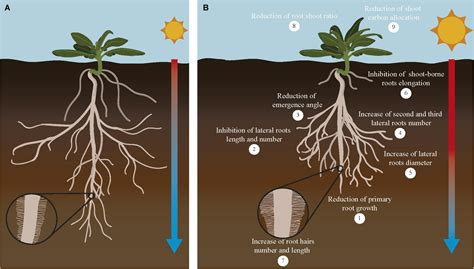Do you ever wonder how plants manage to find water deep within the soil during dry spells? Well, a groundbreaking study conducted by plant scientists from the University of Nottingham and Shanghai Jiao Tong University has shed light on this remarkable phenomenon. They have unraveled the role of a key plant hormone called abscisic acid (ABA) in influencing root growth angles in essential cereal crops like rice and maize.
“Finding ways to tackle food insecurity is vital…to help plants improve crop yields during droughts.” – Dr. Rahul Bhosal
Drought, a persistent threat to global food security, has spurred researchers worldwide to explore innovative strategies for developing drought-resistant crops with robust root systems that can thrive under water-stressed conditions. With an alarming rise in global population expected to reach 10 billion by 2050 and escalating freshwater scarcity, the urgency of enhancing crop resilience against drought cannot be overstated.
Plants, much like us, have their own way of seeking out life’s essentials – in their case, water. The intricate network of roots serves as their lifeline to absorb nutrients and moisture from the soil. However, when faced with drought conditions, where water becomes scarce at the surface level and remains concealed in deeper soil layers, plants must adapt swiftly to survive. This is where abscisic acid (ABA) steps in as a crucial player in helping plants navigate through challenging circumstances.
In this recent study published in Current Biology, researchers uncovered a fascinating interplay between ABA and another essential plant hormone known as auxin. Together, these hormones orchestrate the intricate dance of root growth angles that enable plants to venture into deeper subsoils in quest of precious water reservoirs. By elucidating this molecular mechanism orchestrated by ABA and auxin, scientists are paving the way for novel approaches towards fortifying crops against drought stress.
The research team unearthed a novel pathway wherein ABA triggers the production of auxin within plants. This surge in auxin levels enhances root gravitropism – the phenomenon where roots grow at steeper inclinations in response to gravity cues under dry conditions. Experiments conducted on mutant plants lacking ABA production revealed shallower root angles and diminished responsiveness to gravity-induced bending compared to normal counterparts.
“This new study gives fresh insights into how ABA alters root growth…depths for water.”
Interestingly, these deficiencies were attributed to lower levels of auxin present in their roots. Remarkably though, upon external application of auxin by researchers, normal root growth patterns were reinstated in these mutants – underscoring the indispensable role played by auxin modulation controlled by ABA signaling pathways.
The significance of these findings transcends specific cereal crops like rice and maize; it holds promise for revolutionizing drought resilience across diverse crop species facing similar challenges globally. Driven by a vision to combat food insecurity head-on, lead author Dr.Rahul Bhosal emphasized that unraveling nature’s mechanisms governing plant development brings us closer towards engineering innovative solutions that bolster crop productivity amid harsh environmental adversitiessuch as drought.
As we delve deeper into understanding how plants harness their innate abilities guided by intricate hormonal regulations such as those involving ABA and auxin interplay,the prospectof cultivating resilient crops capableof sustaining yields even amidst climatic uncertainties appears more tangible than ever before.The journey towards enhancing agricultural sustainability continues unabated,relying on discoveries like these tounlock nature’s secretsfor nourishing our growing world population.

